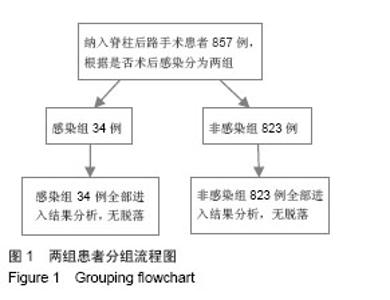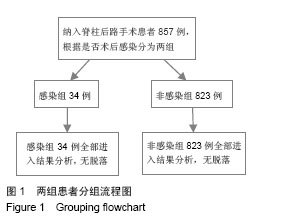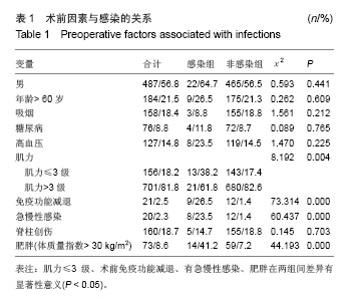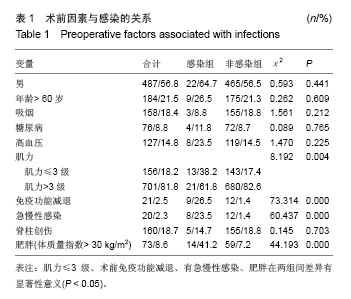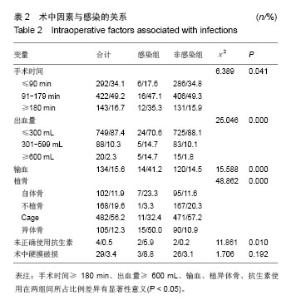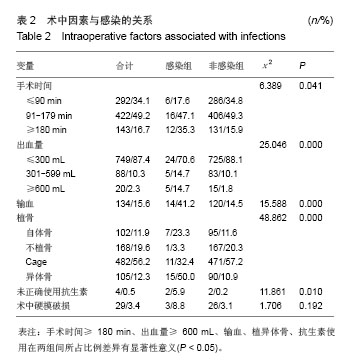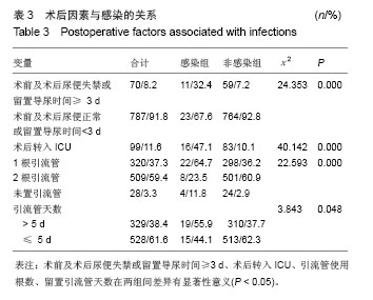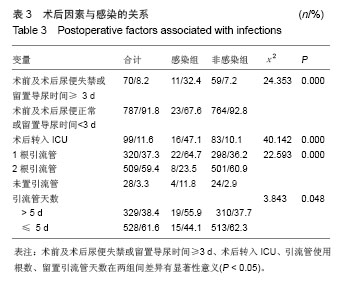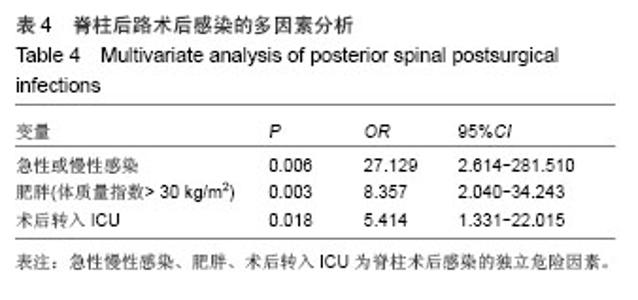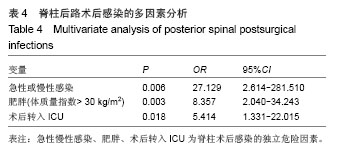| [1]Antoine G,Juan CRO,Fabian B.Infections in spinal instrumentation. Int Orthop(SICOT). 2012;36:457-464.
[2]Manish K,Kasliwal, Lee A. Infection with spinal instrumentation: Review of pathogenesis, diagnosis, prevention, and management. Surg Neurol Int. 2013;4: S392-403.
[3]Zucherman J, Hsu K, White A, et al. Early results of spinal fusion using variable spine plating system. Spine. 1988; 13: 570-579.
[4]Amy M, Michael J, Brook I, et al. Using the Spine Surgical Invasiveness Index to Identify Risk of Surgical Site Infection. J Bone Joint Surg. 2012;94:335-342.
[5]Olsen MA, Nepple JJ, Riew KD, et al. Risk factors for surgical site infection following orthopaedic spinal operations. J Bone Joint Surg Am. 2008;90(1):62-69.
[6]缪锦浩,陈德玉.脊柱手术后切口感染的危险因素.[J].中国脊柱脊髓杂志,2010,20(3):246-247.
[7]Abdul-Jabbar , Amir BA ,Takemoto S, et al. Surgical site infection in spinal surgery. Spine. 2012;37(15):1340-1345.
[8]Bobby DK, Wellington KH, Gildasio S, et al. Operative Duration as an Independent Risk Factor for Postoperative Complications in Single-Level Lumbar Fusion. Spine. 2014; 39(6):510-520.
[9]Murphy GJ, Reeves BC, Rogers CA, et al. Increased mortality,postoperative morbidity, and cost after red blood cell transfusion in patients having cardiac surgery. Cardiovas Surg. 2007;116(22):2544-2552.
[10]Maragakis LL, Cosgrove SE, Martinez EA, et al. Intraoperative fraction of inspired oxygen is a modifiable risk factor for suigical site infection after spinal surgery. Anesthesiology. 2009;110(3):556-562.
[11]Schimmel JP, Horsting PP, Kleuver M, et al. Risk factors for deep surgical site infections after spinal fusion. Eur Spine J. 2010;19:1711-1719.
[12]Linam WM, Margolis PA, Staat MA, et al. Risk factors associated with surgical site infection after pediatric posterior spinal fusion procedure. Infect Control Hosp Epidemiol. 2009;30(2):109-116.
[13]Kaisorn L, Bydon M, David R. Risk of infection following posterior instrumented lumbar fusion for degenerative spine disease in 817 consecutive cases.J Neurosurg Spine. 2014; 20:45-52.
[14]刘少强,齐强陈,陈仲强,等.腰椎术后感染的危险因素及合理防治[J].中华外科杂志,2013,51(12):1128-1131.
[15]熊敏,应文娟.重症监护室医院感染监测及对策[J].中华医院感染学杂志,2005,15(4):447.
[16]Xing D,Ma JX, Ma XL,et al. A methodological, systematic review of evidence-based independent risk factors for surgical site infections after spinal surgery. Eur Spine J. 2013; 22:605-615.
[17]Strom RG, Pacione D, Kalhorn SP, et al. Decreased Risk of Wound Infection After Posterior Cervical Fusion With Routine Local Application of Vancomycin Powder. Spine. 2013;38(12): 991-994.
[18]Hegde V, Meredith DS, Christopher K, et al. Management of postoperative spinal infections. World J Orthop. 2012;3(11): 182-189.
[19]田耘,陈仲强,刘忠军,等.脊柱术后伤口深部感染的处理[J].中华外科杂志,2005,43(4):229-231.
[20]Hong HS, Chang MC, Liu CL, et al. Is aggressive surgery necessary for acute postoperative deep spinal wound infection. Spine. 2008;33:2473-2478 .
[21]Mok JM, Guillaume TJ, Talu U, et al. Clinical outcome of deep wound infection after instrumented posterior spinal fusion: a matched cohort analysis. Spine. 2009;34:578-583.
[22]Jahoda D, Nyc O, Pokorny D, et al. Antibiotic treatment for prevention of infectious complications in joint replacement. Acta Chir Orthop Traumatol Cech. 2006;73(2):108-114.
[23]Barnes M, Liew S. The Incidence of Infection after Posterior Cervical Spine Surgery: A 10 Year Review. Global Spine J. 2012;2:3-6.
[24]Martin JR, Adogwa O, Brown CR, et al. Experience With Intrawound Vancomycin Powder for Spinal Deformity Surgery. Spine. 2013;39(2):177-184.
[25]Fang XT, Wood KB. Management of postoperative instrumented spinal wound infection. Chin Med J (Engl). 2013; 126(20):3817-3821.
[26]Andrew J , Leah M , Julia O, et al. Risk Factors for Immediate Postoperative Complications and Mortality Following Spine Surgery: A Study of 3475 Patients from the National Surgical Quality Improvement Program.. J Bone Joint Surg Am. 2011; 93:1-7.
[27]陈鹏,陈刚,朱国兴,等.腰椎术后感染的原因分析与治疗策略[J]. 临床骨科杂,2013,16(5):506-509.
[28]张明德,朱俊峰.全髋关节置换术后感染的危险因素分析及早期诊断[J].重庆医学,2013:42(33):3999-4003.
[29]王荣强.脊柱手术后并发感染的原因及处理[J].中国实用医药, 2014:9(3):79-80.
[30]马振江,赵杰,娄伟刚,等.脊柱手术部位感染的危险因素及预防措施研究进展[J].中国脊柱脊髓杂志,2014, 24(3):279-283. |
